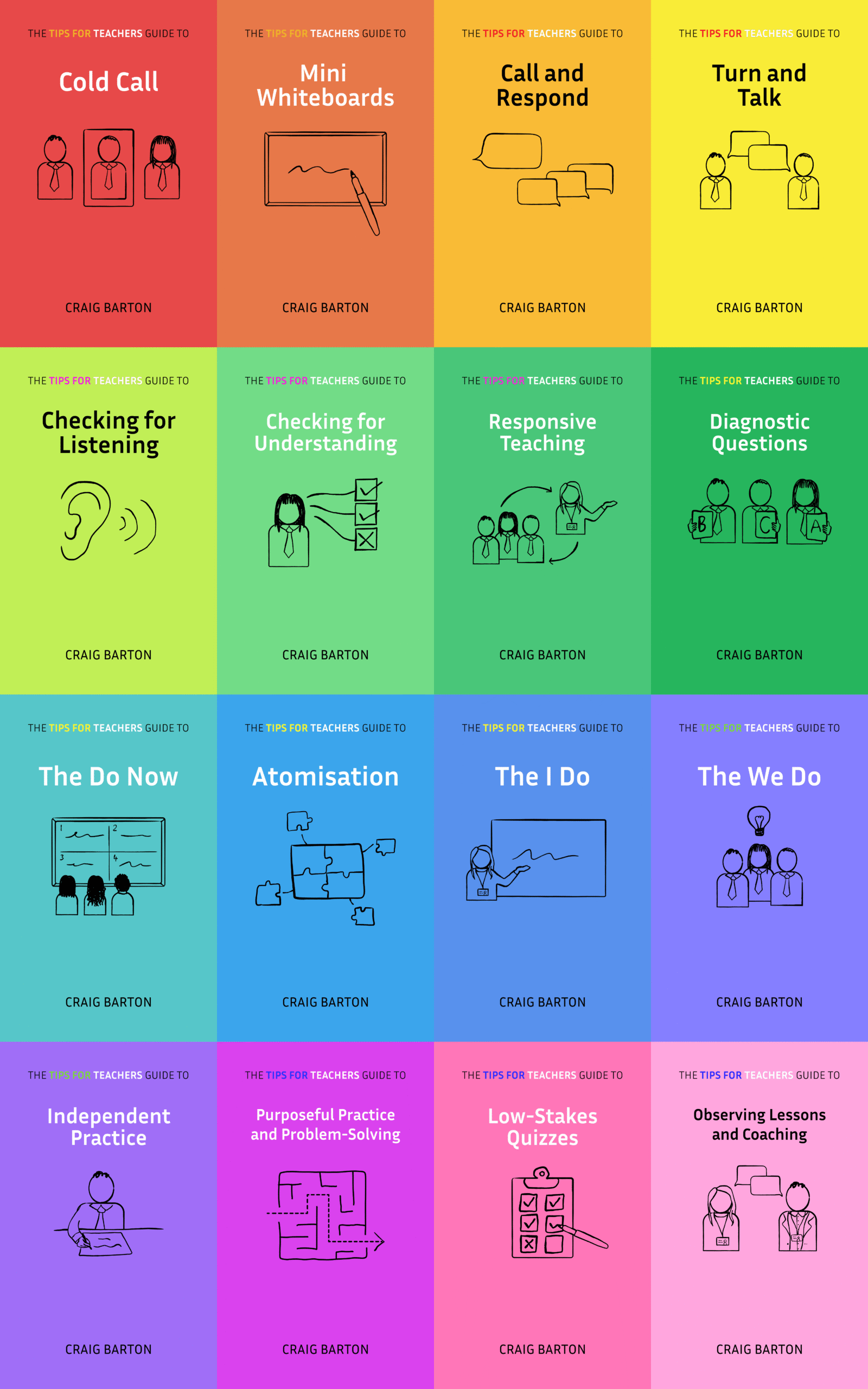
What is ratio?
Ratio is a powerful concept when considering your or your colleagues’ lessons. Doug Lemov coined the term in Teach Like a Champion, and Adam Boxer explains it well here.
Ratio describes how much thought occurs at any one time in a lesson. There are two components:
- Participation ratio: how many students are thinknig?
- Think ratio: how hard are students thinking
This leads us to a neat set of axes:

We want each phase of our lesson to sit in the top-right quadrant. To get there, it makes sense to travel to the right first—in other words, there is little point trying to drive up the Think ratio until we have lots of students thinking.
That is the aim of this section: to consider how to drive up the Participation ratio for key phases of our lessons. We will discuss the Think ratio when we look at checking for understanding.
Diagnosis
To start this process, we need a baseline. Here is an exercise I regularly do with teachers in the schools I support. To play along, get yourself a piece of paper or a mini-whiteboard.
Let’s consider 5 key phases of a lesson:
- Retreival Do Now
- Pre-requsaite knoweldge check
- I Do
- We Do
- Consolidation
Not every lesson will contain all 5 phases, but hopefully these are common enough to make this exercise useful.
Write these 5 phases on your piece of paper/mini-whiteboard like this:

Think about the most recent lesson you taught. Underneath each lesson phase, write down how your students participated.
Here is a list of common means of paritcipation to help you:
- Writing in books or on a worksheet
- Volunteering to answer
- Answering via Cold Call
- Answering via Call and Respond
- Finger or card voting
- Writing on a mini-whiteboard
- Turn and Talk
- Group work
So, if your students answer their Do Now in their books, and then you go through the answers by Cold Calling students, your board would look like this:

Do the same for each lesson phase. If there is a phase you did not do, or combined with another phase, just leave it out.
Now comes the fun bit. Please consider the Participation ratio in each lesson phase. A good way to do this is to ask the following question:
How easy would it be for a student to not be thinking in that phase of the lesson and you not pick up on it?
Be really honest.
If you are convinced that almost all your students were thinking in, say, your Do Now, then grade that phase of your lesson an H, standing for High Participation ratio.
If you think some students were taking but others were not, grade that phase of your lesson M, standing for Medium Participation ratio.
If you think that most students were not thinking, then grade that phase of your lesson L, standing for Low Participation ratio.
Do this for each lesson phase.
If you are doing this exercise with a colleague, now is a good time to put your pieces of paper/whiteboards between you and compare each lesson phase. If they have given a lesson phase a grade higher than you, ask them what they are doing that you are not doing.
Evidence
When I watch lessons, I always think about the Participation ratio. When you really consider what is happening, the Participation ratio is often lower than the teacher imagines. Here are some examples:
The Do Now

Students complete the Do Now in their books. Some students spend most of the time copying the date and title, and some don’t even bother doing that. The teacher spends most of the time at the front of the class doing the register. When the teacher does circulate, students pick up their pens and appear busy. Then, the teacher goes through the answers using a combination of Cold Calling and asking for volunteers. Students copy some answers from the board and tick them with a purple pen.
The pre-requisite knowledge check

When it occurs – and it often doesn’t – the prerequisite knowledge check often plays out in a similar way to the Do Now. Some studetns engage, others sit back and let others do the work, copying down the final answer off the board if they can be bothered.
The I Do

I see two types of I Dos. The first is co-constructed, where the teacher asks for volunteers or Cold-Calls individual students to suggest the next step in the solution. The other is teacher-led, where the teacher explains each step of the process while students silently look at the board.
The We Do

Again, often, students participate individually via Cold Call or volunteering. The teacher only hears from a small number of students.
Consolidation

Students vary in the amount of work they get through. Some only work when the teacher is near, while others copy off their partner. At the end of the consolidation, the teacher puts the answers on the board, tells students to tick the ones they got right, correct the ones they didn’t, asks if there are any questions (there very rarely are), and then that’s the end of the lesson.
In each of the scenarios above, I think the Participation ratio is low. It would be very easy for a large number of children to get away with doing very little thinking and the teacher not be aware of it.
Do you want to adjust any of your gradings based on this?
Which phase of your lesson would most benefit from a boost in the Participation raio?
Solution steps
For the rest of this section, we will consider various means of participation and look at concrete strategies to boost the Participation ratio.
Want to know more?
If you want to read more about ratio, I recommend the following:








